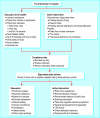Promoting urinary continence in women after delivery: randomised controlled trial
- PMID: 12028976
- PMCID: PMC113274
- DOI: 10.1136/bmj.324.7348.1241
Promoting urinary continence in women after delivery: randomised controlled trial
Abstract
Objectives: To test the effectiveness of a physiotherapist delivered intervention designed to prevent urinary incontinence among women three months after giving birth.
Design: Prospective randomised controlled trial with women randomised to receive the intervention (which entailed training in pelvic floor exercises and incorporated strategies to improve adherence) or usual postpartum care.
Setting: Postpartum wards of three tertiary teaching hospitals in the Hunter region, New South Wales, Australia.
Participants: Women who had forceps or ventouse deliveries or whose babies had a high birth weight (> or =4000 g), or both-676 (348 in the intervention group and 328 in the usual care group) provided endpoint data at three months.
Main outcome measures: Urinary incontinence at three months measured as a dichotomous variable. The severity of incontinence was also measured. Self report of the frequency of performance of pelvic floor exercises was recorded.
Results: At three months after delivery, the prevalence of incontinence in the intervention group was 31.0% (108 women) and in the usual care group 38.4% (125 women); difference 7.4% (95% confidence interval 0.2% to 14.6%, P=0.044). At follow up significantly fewer women with incontinence were classified as severe in the intervention group (10.1%) v (17.0%), difference 7.0%, 1.6% to 11.8%). The proportions of women reporting doing pelvic floor exercises at adequate levels was 84% (80% to 88%) for the intervention group and 58% (52% to 63%) for the usual care group (P=0.001).
Conclusions: The intervention promoting urinary continence reduced the prevalence of urinary incontinence after giving birth, particularly its severity, and promoted the performance of pelvic floor exercises at adequate levels; both continence and adherence to the programme were measured at three months after delivery in women who had forceps or ventouse deliveries or babies weighing 4000 g or more.
Figures
Comment in
-
Postpartum urinary incontinence.BMJ. 2002 May 25;324(7348):1227-8. doi: 10.1136/bmj.324.7348.1227. BMJ. 2002. PMID: 12028960 Free PMC article. No abstract available.
-
A tailored pelvic floor exercise program commenced immediately post-partum promotes continence.Aust J Physiother. 2002;48(4):317. doi: 10.1016/s0004-9514(14)60175-6. Aust J Physiother. 2002. PMID: 12542035 No abstract available.
References
-
- Simeonova Z, Bengtsson C. Prevalence of urinary incontinence among women at a Swedish primary health care centre. Scand J Primary Healthcare. 1990;8:203–206. - PubMed
-
- Nygaard I, DeLancey JOL, Arnsdorf L, Murphy E. Exercise and incontinence. Obstet Gynecol. 1990;75:848–851. - PubMed
-
- Clark A, Romm J. Effect of urinary incontinence on sexual activity in women. J Reprod Med. 1993;38:679–683. - PubMed
-
- Herzog AR, Fultz NH, Brock BM, Brown MB, Diokno AC. Urinary incontinence and psychological distress among older adults. Psychol Aging. 1988;3:115–121. - PubMed
-
- Lagro-Janssen T, Smits A, VanWeel C. Urinary incontinence in women and the effects on their lives. Scand J Primary Health Care. 1992;10:211–216. - PubMed
Publication types
MeSH terms
LinkOut - more resources
Full Text Sources
Medical


